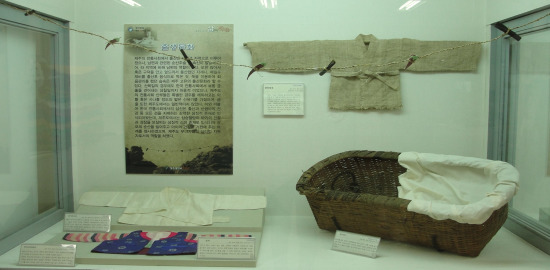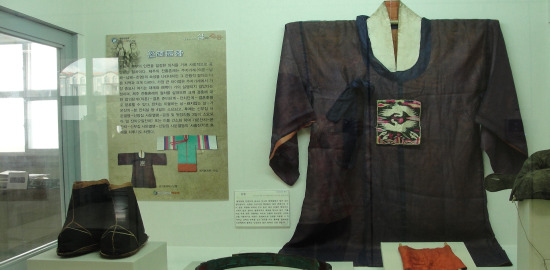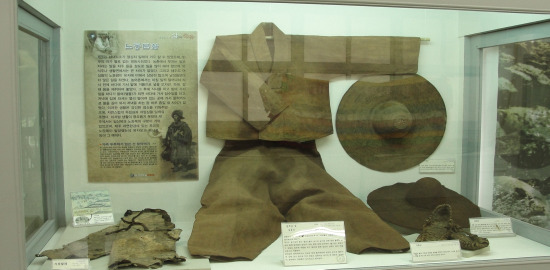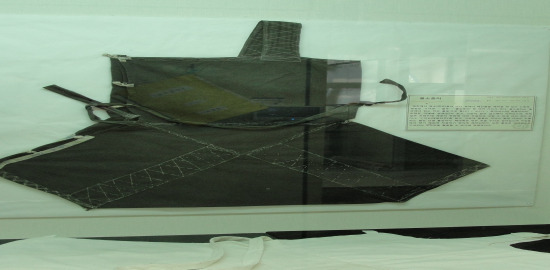Clothes are something we wear throughout life and even in death.
We generally regard them as just outer garments to maintain our body to be warm. But sometimes we should remind ourselves of clothing. Clothes help us see our ancestors’ way of life in the past. They give us glimpses of the natural environment and culture that has persisted in Korea for centuries.
Especially in Jeju, work clothes and everyday dress have been perfectly adapted to the environment of the island. In such a fashion, we can understand something about the daily lives of the people born and raised in this barren land. The practical and sturdy dress of Jeju people tells a story of hard, and continuous efforts to make a living in a rough environment.
The Islander was interested in learning more about Jeju clothing, so we sent along a reporter to the clothes exhibition held in the JNU Museum from May 24 to August 31 to see what was on display.
The clothes exhibition of Jeju is divided into four parts: culture of birth, marriage, work, and death. By looking around each section, a clear picture emerges as for how Jeju people wear throughout their lives.

Guided through the exhibit by footprints made with colored paper, we first came upon the space dedicated to the culture of birth. On prominent display was the white-colored traditional clothing botdwichangot(봇뒤창옷) which Jeju mothers place on their newborn infants. It is made of “hemp cloth”, so it helps babies stay cooler in hot weather and is very effective in preventing baby rash. Also as the old saying goes, "A person who couldn't wear this clothing can't be treated as a person after they died. "Even indigent mothers, unable to afford baby clothes, believe it is necessary to borrow or make the white hemp dress for their child. It is clear that not only is the botdwichangot a simple garment to maintain a baby's body heat but also it connotes a parent’s solemn prayer for his or her baby's health.

Next, following the colored footprints, we entered the section on marriage costumes. The ceremonial dresses are not brilliantly colored but they look clean and neat. Wedding fashions were influenced by clothing trends from outside the island and imported here by the nobility. Over time, however, local tailors changed and adapted the styles to create a simple look that is only found in Jeju. This clothing reflects the culture of Jeju people, who generally tend to avoid pretense and ostentatious displays of wealth.

After that, as we moved along the colored path, we found ourselves in the section pertaining to work clothes. Here one can observe galjeoksam(갈적삼), an unlined summer jacket dyed a yellowish red. It is Jeju’s traditional clothing, and Jeju people often wore it for both working clothes and everyday clothes. Especially, it is the best working clothes for farmers and fishermen who have to work hard in the hot summer weather. Putting on this clothing, they feel comfortable and cool. Hence, even now, many people wear galjeoksam in summer.

In this section, we also stopped to consider the traditional diving suit mulsojungi(물소중이) of Jeju women divers, haenyeo. Diving was no idle recreation for these women, but an essential part of the tasks required for survival on the island. In the past, unlike on the mainland, women worked more than men in Jeju. They had to do the farm work, go to sea for food, and even do all the household chores. Basically, they had little time to rest from sunup to sundown.
The design of their diving suits was simple and efficient. By exposing their arms and legs while hiding bust and body, the suit allowed women to maneuver with ease underwater. It quickly changes from wet to dry in preparation for the next task of the day. The dark color and strong materials also provided great insulation from the cold and deep sea underwaters.


Last, the footprints lead us to the section on clothes associated with funeral rites on the island. Chief mourners wear what is called a cheobok(최복) when they attend the funeral services of their family members. Stains on the clothing seem like tearstains of sadness.
According to tradition, to get dressed up as a mourner was to extend a courtesy to the dead, a solemn way for surviving people to say goodbye to dead when they are at the crossroad of life and death.
We finished our travel through the styles of clothing characterizing the lives of Jeju people. The clothes vividly express lives permeated by strong traditions and endless hard work. They leave us wondering in what ways the styles of today continue to reflect the clothes and traditions of the past and in what ways they reveal the unique lifestyle of our own generation.

